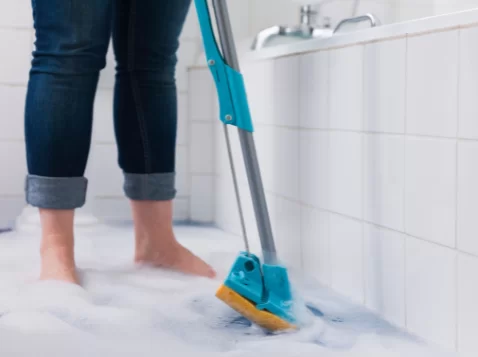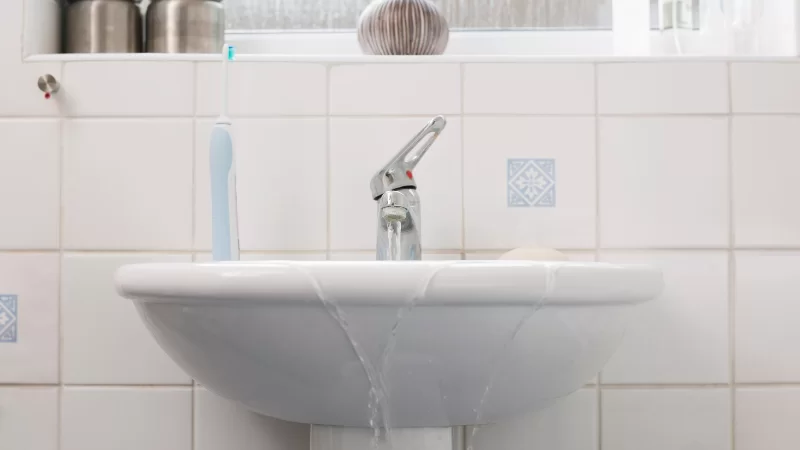Dealing with flooding in your home is a stressful experience as it can cause a lot of damage and leave you feeling overwhelmed. While flooding and water damage can happen anywhere in your home, certain areas are more vulnerable, such as the bathroom. It is important to check your bathrooms regularly for any signs of water damage and know what to do when water damage or flooding occurs.

Flooding in your bathroom can happen due to a number of reasons such leaks under the sink, clogged toilets, or even bathtub overflows. No matter the reason your bathroom is flooded, it can cause some major damage to your property. Flooding in your bathroom can quickly seep into the floor and subfloor; soak the baseboards, drywall, and cabinets; and create an environment ideal for mold to form within 24 hours. It is very important to react quickly and get the water cleaned up before it causes further damage or leads to mold growth.
What causes bathroom flooding?
Here are some common reasons why your bathroom may flood:
- Issues with plumbing such as frozen or burst pipes or old supply lines that rupture due to extra water pressure.
- If you have a blocked toilet issue, you may end up with an overflowing toilet.
- Sometimes hair or wet wipes can clog a toilet and cause further plumbing issues.
- You may have an issue with your drain if it fails, or if you run a bath that overfills, which can end up flooding your bathroom.
- A storm can cause a sewer main backup and fill up your bathroom with sewage. Tree roots can crack, clog, and back up sewer lines as well.

How to recover a flooded bathroom?
Here are some ways you can recover a flooded bathroom:
It is important to know where the flooding in your bathroom is coming from. Check for any wet areas on your walls and behind the toilet for signs of water damage. Make sure you know where your main shut off valve is for the water in your home. Shut off the main water supply and start cleaning up by mopping and soaking up the water.
Make sure that you turn off the breaker for the bathroom so you can keep yourself and the appliances in the bathroom safe. Before you try unplugging something, check if the outlet has been exposed to water. Also, make sure to move any electrical items out of the area.
If you are having plumbing issues in your bathroom, make sure to fix them right away. Whether it is a pipe or a line that is leaking, call a plumber to fix the issue. If it is your toilet that is leaking, you may need to replace the wax ring around the flange or to tighten the toilet base. However, if the cause of the leak is a broken pipe behind the bathroom wall, make sure to contact professionals to fix it.
Contact your insurance and document the damage
Contact your insurance company after you find the damage and let them know about the water damage in your bathroom. You should take pictures and document the damage so that it is easier for you to file the claim.
Take a step back and assess the damage
Make sure to clean up the water damage quickly and efficiently to prevent further damage and mold growth. If you are unable to clean up all the water yourself quickly, you should call the professionals and let them handle it instead.
Prepare to clean up the damage
Before you start the cleanup process, make sure to move everything out of the way. Take the cabinets out, move any furniture, and get rid of items that are too wet to be fixed.
Get rid of standing water
Soak up the water using towels. You can also use a mop and bucket for a larger amount of water. If you have a wet vac, it is a great way to pick up large amounts of water as well.
Start the drying out process
Set up fans as needed to circulate fresh air. You should also run a dehumidifier in the wet bathroom. You can either buy these items to help you dry out the area or you can rent them from a home improvement center.
Remove and replace the drywall
Check out the drywall in your bathroom for any wet patches. These will need to be torn out and patched and you may also need to replace whole areas of the wall. If you do not address water damage to the drywall, you may experience further structural damage or mold growth.
Make sure to give your bathroom a good scrubbing. All surfaces will need to be disinfected such as the floor, the tub, toilet, cabinet bases, trim, and baseboard. Thorough cleaning will ensure that the contaminants have been removed and the bathroom is safe for use.
ServiceMaster Restoration and Cleaning
Have you experienced bathroom flooding at your home or business? ServiceMaster Restoration and Cleaning can help. Whether your bathroom is flooded due to a sewage backup, a clogged toilet, or a plumbing issue, we will clean and restore it quickly and efficiently.
For all of your water damage restoration needs, make sure to call ServiceMaster Restoration and Cleaning today at 1-800-303-5844.

